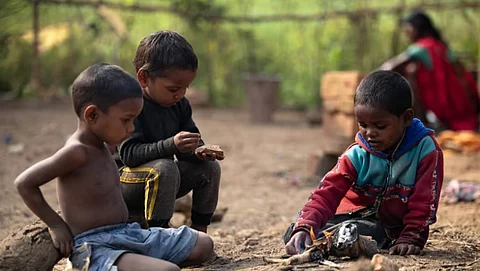

Politicians from the country’s ruling party are trying to capitalise on the latest State Bank of India (SBI) survey claiming that poverty has reached less than five per cent in both urban and rural areas, even as economists and experts are questioning the findings. Now, a research paper has stated that every fourth person in India is poor.
This paper, published in The Journal of the Foundation for Agrarian Studies (FAS), states that about 26.4 per cent of people in India are poor. The article is titled Poverty in India: The Rangarajan Method and the Household Consumption and Expenditure Survey 2022-23.
The authors of the research paper estimated the poverty line based on the Household Consumption Expenditure Survey 2022-23, using the methodology suggested by the Rangarajan Committee. They had estimated the poverty line at Rs 2,515 in rural areas and Rs 3,639 in urban areas. Based on this estimate, the number of poor in the country has been estimated at 26.4 per cent.
The poverty line was last determined in 2011-12. Then, there were no conversations regarding it for more than a decade. After almost 12 years, the National Sample Survey Office (NSO) released the Household Consumption Expenditure Survey 2022-23 in February 2024. Since national income and poverty level are measured on the basis of this survey, discussions about the poverty line gained momentum in the country.
However, the government has not released any poverty estimate based on this survey even after 11 months. But using this survey, two different estimates have been issued so far.
The National Council of Applied Economic Research (NCAER) had said in its India Human Development Survey estimates that the number of poor in India would reach below 10 per cent in the year 2023, which was 21 per cent in 2011-12. At the same time, SBI said the number of poor has reached below five per cent.
But both estimates have been rejected in the paper published in the journal of FAS.
This document was followed by an online panel discussion on poverty measurement methodology organised by the Foundation for Agrarian Studies (FAS), Bengaluru. There, one of the authors, C A Sethu, clarified that despite underestimating the poverty line and overestimating the upper limit, he and the others found that every fourth Indian is poor.
Apart from Sethu, the other authors of the paper include L T Abhinav Surya, and C A Ruthu. Sethu is a senior research assistant at the FAS, while Abhinav Surya is a PhD scholar at the Centre for Development Studies and Ruthu is attached to the office of the vice-chairman of the Kerala State Planning Board.
The paper states that the method of adjusting the poverty line in the past using the consumer price index is wrong for at least two major reasons. First, Consumer Price Index is calculated using the old base weights for the items in the consumption basket. While these weights have not been updated for over a decade due to the absence of new consumption expenditure data, there is every possibility of change.
The second and more important reason is that the Consumer Price Index, as is clear here, is not a means of tracking poverty. The consumption patterns and prices of people living below the poverty line are different from the consumption patterns and prices of people above the poverty line.
The authors have said that this is the reason why our estimates are higher than the figures quoted by C Rangarajan and S M Dev in a 2024 article for the Indian Express. Rangarajan and Dev had derived their figures by adjusting the 2011-12 poverty line of the Expert Group (2014) using the Consumer Price Index.
They add that their results should also be read in the context of evidence from research on rural wages, farm household incomes, and the informal sector, which suggests that the incomes of the rural poor have not increased substantially.
Data from the Situation Assessment Surveys of Agricultural Households of 2012-13 and 2018-19 show that the average monthly income of agricultural households has grown at the rate of 2.44 per cent per annum between these years, from Rs 8,843 to Rs 10,218 at constant prices.
The authors also said that, “We find that the methodology we use (Rangarajan) is likely to underestimate poverty, rather than overestimate it. Consumption poverty remains an urgent and important problem in India.”
The article also questions the comparison between the Consumer Expenditure Survey (CES) of 2011-12 and the Household Consumer Expenditure Survey (HCES) of 2022-23, despite significant differences. While the new HCES 2022-23 collected information on commodities like free rice and sugar supplied through the Public Distribution System (PDS), this was not done in the CES 2011-12.
It is important to mention here that the researchers of NCAER and FAS used the Rangarajan Committee’s method to estimate poverty, whereas the SBI researchers used the Tendulkar Committee’s method.
SBI estimated the poverty line in FY24 at Rs 1,632 for rural areas and Rs 1,944 for urban areas. When the poverty population ratio in India was estimated at 21.9 per cent in 2012, it was done by applying the data of the expert group formed to review the methodology of the committee headed by Suresh Tendulkar.
But when this calculation of the poverty line was criticised, the Planning Commission of the Government of India appointed an expert group under the chairmanship of C Rangarajan to “re-review” the methodology for measuring poverty.
This expert group, in its report submitted in June 2014, proposed an alternative method of calculating the poverty line and estimated that the poverty ratio in India in 2011-12 using this method was 29.5 per cent of the Indian population. However, the Government of India did not give its official approval to this estimate.